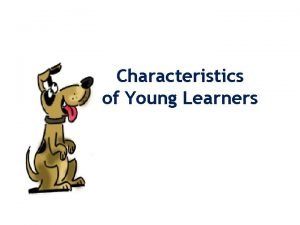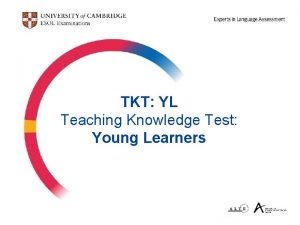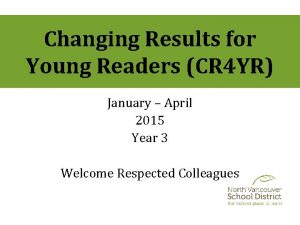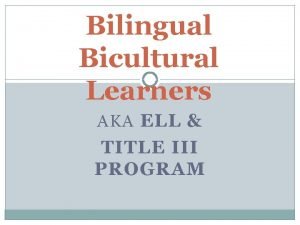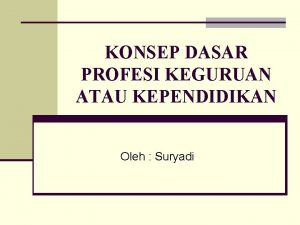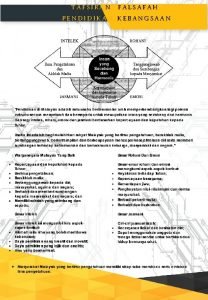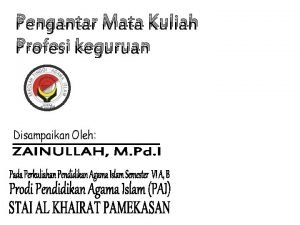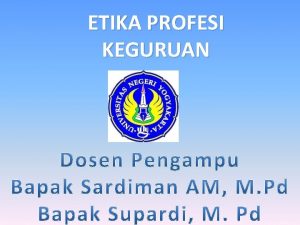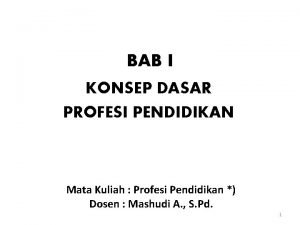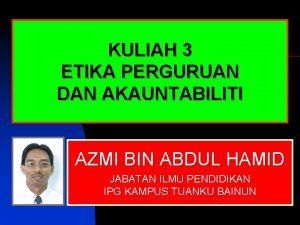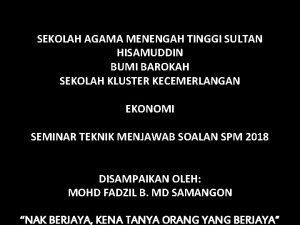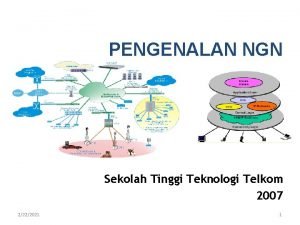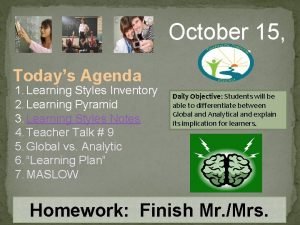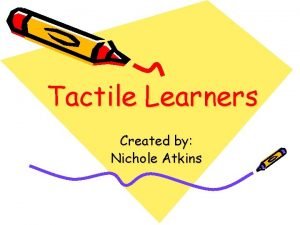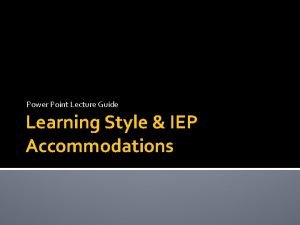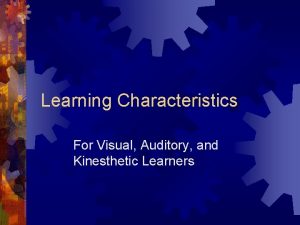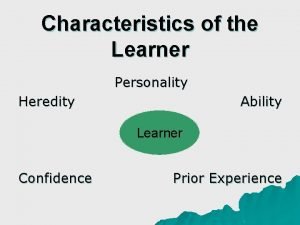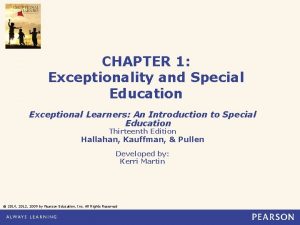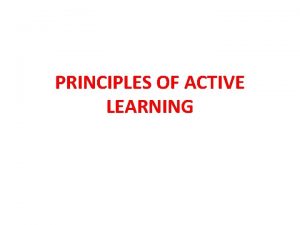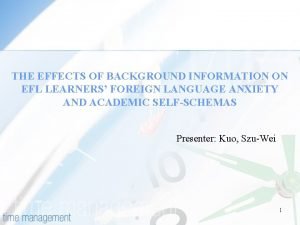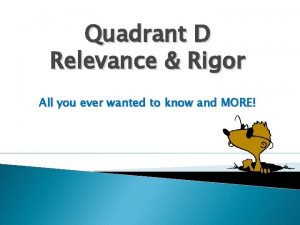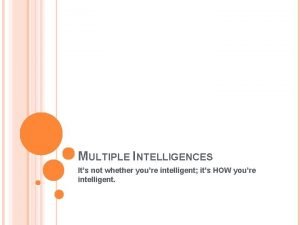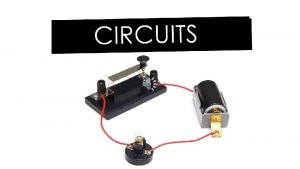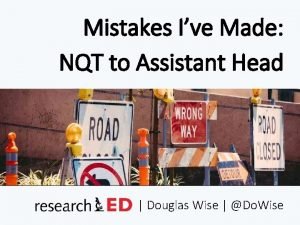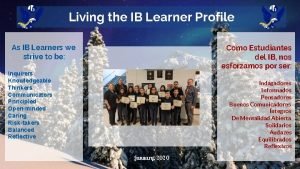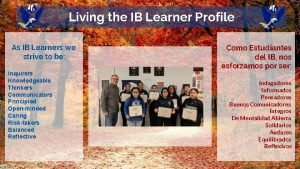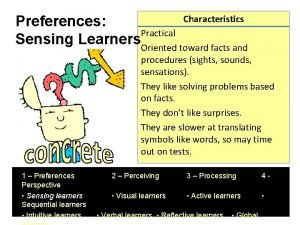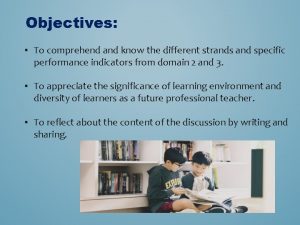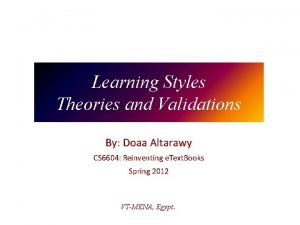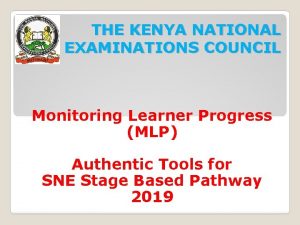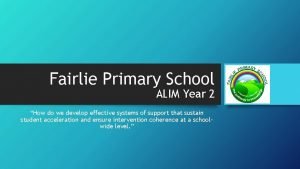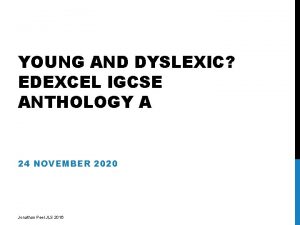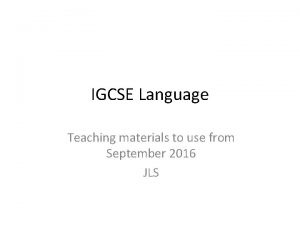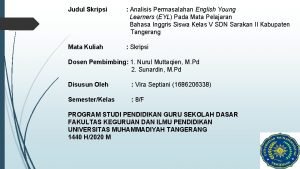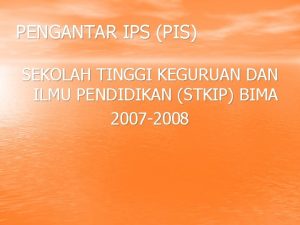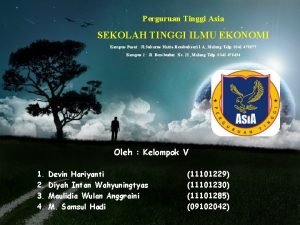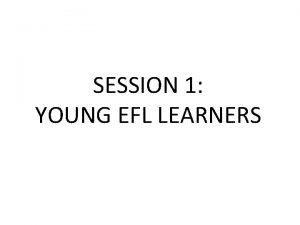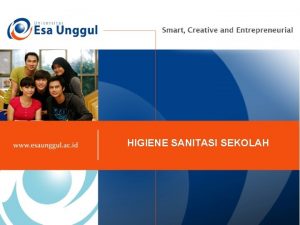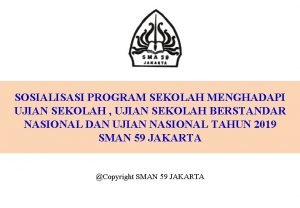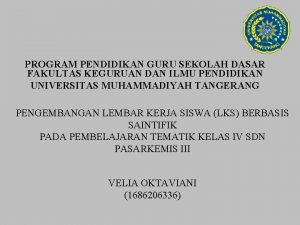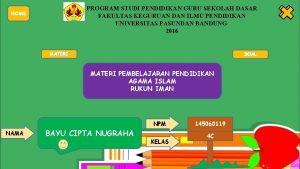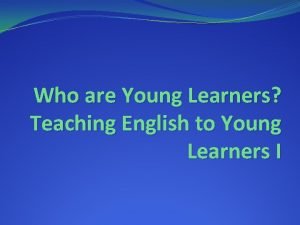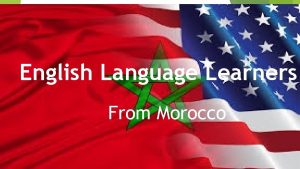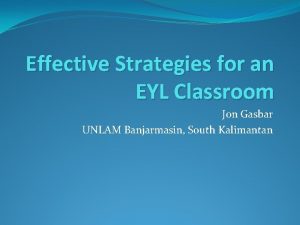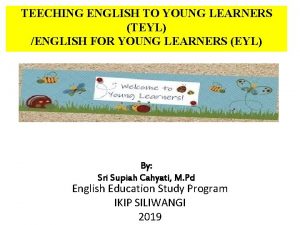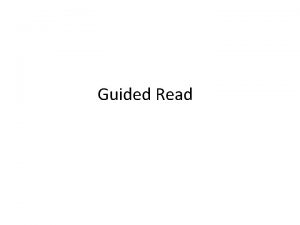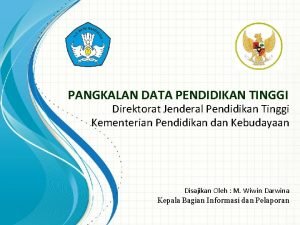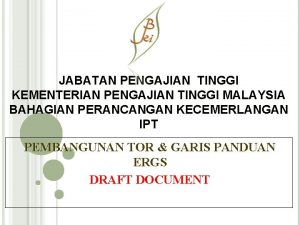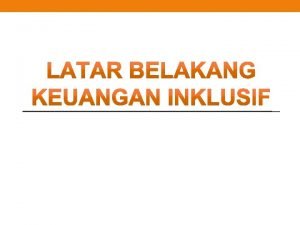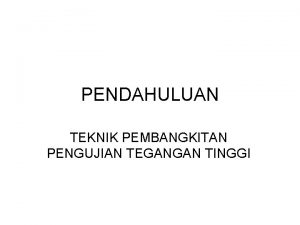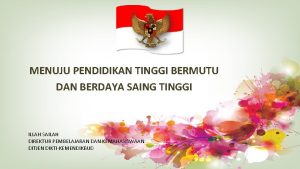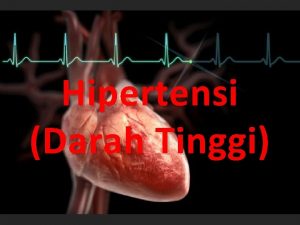ENGLISH FOR YOUNG LEARNERS EYL Sekolah Tinggi Keguruan





















































































































- Slides: 117

ENGLISH FOR YOUNG LEARNERS (EYL) Sekolah Tinggi Keguruan & Ilmu Kependidikan (STKIP Siliwangi) Bandung

Slattery & Willis (2005) TEVYL: Teaching English to Very Young Learners (children under 7). TEYL: Teaching English to Young Learners (children between 7 -12). Pinter (2006) Older learners: children at junior & senior high school. Adult learners: students at university level/above secondary school.

Factors influencing successful in language learning (Brewster, Ellis, Gerard, 2003) • • Motivation Willing to make mistakes Good at guessing Making accurate prediction

Noticing Wanting Linking/ Internalization Succeeding Child-Centered Learning (Paul, 2003) Challenging/ Taking a risk Playing/ Experimenting The teacher explained/demonstrated before the children started practicing.

What can go wrong? • We do not give the children space to notice. • They do what we want them to do. • They do not try for themselves. • They do not experiment enough. • They are unsuccessful. • They do not make links.

Misconceptions in teaching approach to younger learners can lead to failure (Musthafa, 2000) • Teacher tend to approach the teaching-learning process & employ teaching methods & techniques for the teaching English to young learners in an exactly the same way as they would teach adult learners. • Actually, children have their own culture & learning preferences. They learn by way of physical activities that embedded in their daily life, they have a relatively short attention span, & they learn with the motive of meeting immediate goals (here & now principle)

Some myths and misconceptions about second/foreign language learning (Musthafa: 2000) A. Children learn second/foreign languages quickly & easily. Adolescents & adults perform better than young children under controlled conditions, except pronunciation. Young children do not have access to the memory techniques & other strategies that more experiences learners use in acquiring vocabulary & in learning grammatical rules. Children are more likely to be shy & embarrassed around peers that are adults.

Some myths and misconceptions about second/foreign language learning (Musthafa: 2000) B. The younger the child, the more skilled in acquiring an L 2/FL Oyama (in Pinter, 2006) found that the earlier a learner begins a second language, the more native like the accent he/she developed. An early start for “foreign” language learners makes a long sequence of instruction leading to potential communicative proficiency possible & enables children to view L 2 learning & related cultural insight as normal & integral. Beginning language instruction gives children more exposure to the language.

Some myths and misconceptions about second/foreign language learning (Musthafa: 2000) C. The more time students spend in an L 2/FL context, the quicker they learn the language. The increased exposure to English does not necessarily speed the acquisition of English. Children with exposure to the home language & to English acquire English language skills equivalent to those acquired by children who have been in English-only program.

Some myths and misconceptions about second/foreign language learning (Musthafa: 2000) D. Children have acquired an L 2/FL once they can speak it For school-aged children, proficiency in face -to-face communication does not imply proficiency in the more complex academic language needed to engage in many classroom activities. Children may have language problems in reading & writing that are not apparent if their oral abilities are used to gauge their English proficiency.

Some myths and misconceptions about second/foreign language learning (Musthafa: 2000) E. All children learn an L 2/FL in the same way Some children are outgoing, sociable & learn the second language quickly, they do not worry about mistakes, but use limited resources to generate input from native speakers. Other children are shy & quite, they learn by listening & watching, they say little, for fear of making a mistake. Children are likely to be more responsive to a teacher who affirms the values of the home culture.

Essential principles of how to facilitate children a foreign language (Pinter, 2006; Andini, 2007; Utami, 2004; Harmer 2002) Giving exposure by using English for the instruction Giving children chances to be engaged in the teaching and learning process Giving support to children Providing good techniques of teaching Providing good media Providing good environment

VYLs (under 7) YLs (7 -12) • Acquire through hearing and experiencing • Are learning to read and write in L 1 lots of English, in much the same way they acquire L 1 • Are developing as thinkers • Learn things through playing; they are not • Understand the difference between the consciously trying to learn new words or real and the imaginary phrases – for them it’s incidental • Can plan and organize how best to carry • Love playing with language sounds, out an activity imitating, and making funny noises • Can work with others and learn from • Not able to organize their learning others • Not able to read or write in L 1; important • Can be reliable and take responsibility for to recycle language through talk and play class activities and routines • Their grammar will develop gradually on its own when exposed to lots of English in context For more information, see: Slattery, M. , & Willis, J. (2001). English for primary teachers. Oxford: Oxford University Press.

Although children may use similar processes for acquiring L 1 and L 2, the environment for L 1 and L 2 acquisition can be quite different (Brewster, Ellis & Girard, 2004). L 1 Environment • language highly contextualized • in the real world the language used is authentic • learner highly motivated L 2 Environment • language more decontextualized • in the classroom the language used tends to be artificial • learners may not be highly motivated Therefore, it is important to remember that an early start alone will not necessarily improve children’s ability to learn English. It is also very important that L 2 instruction include language structures that are presented within a context that is meaningful and communicative.

Now that we have looked at different learning styles and characteristics of young language learners, try to fill in the boxes in this mind map. With a partner, take turns reading each bubble before describing what word best fits each box. Use these words to fill in the boxes: ü Enjoyable ü Full of practice ü Meaningful ü Purposeful ü Social ü Supported This mind map can be found in the following article: Read, C. (1998, April). The challenge of teaching children. English Teaching Professional, 7: 8 -10. Retrieved August 1, 2005, from http: //www. etprofessional. com/articles/challenge. pdf


Characteristics of Young & Adult Learners (Pinter, 2006) • Children are at pre-school/in the first couple of years of schooling. • Generally they have a holistic approach to language, which means that they understand meaningful messages but cannot analyze language yet. • They have lower levels of awareness about themselves as language learners as well as about process of learning. • They have limited reading & writing skills even in their first language. • Generally, they are more concerned about themselves than others. • They have a limited knowledge about the world. • They enjoy fantasy, imagination, & movement.

Characteristics of Older/Adult Learners • These children are well established at school & comfortable with school routines. • They show a growing interest in analytical approaches, which means that they begin to take an interest in language as an abstract system. • They show a growing & their learning. • They have well developed skills as readers & writers. • They have a growing awareness of others & their viewpoints. • They have a growing awareness about the world around us. • They begin to show interest in real life issues.

Skills should be taught in TEYL listening should precede speaking (communicative skills should be the aim of the good language classroom). As in mother tongue learning, English should start with an emphasis on listening & then speaking because children often cannot read & write at all yet. reading and then writing will emerge when the language learner is ready and should not be forced. comprehension of language should precede production.

Theories of Children Learning Development (Mooney, 2000) 1. Sensory-motor stage (from birth to 2 years of age): 2. Pre-operational stage ( from 2 – 7 years of age): The young child learns to interact with the environment by manipulating objects around him. The child thinking is largely reliant on perception but he/she gradually becomes more & more capable of logical thinking. On the whole this stage is characterized by egocentrism & a lack of logical thinking. 1. Jeans Piaget: There are 4 universal stages of development that all children go through & the development was a process of acquiring the principles of formal logic 3. Concrete operational stage (from 7 – 11 years of age): Year 7 is the turning point in cognitive development because children’s thinking begins to resemble “logical” adult-like thinking. They develop the ability to apply logical reasoning in several areas of knowledge at the same time but this ability is restricted to the immediate context. This means that children at this stage cannot yet generalize their understanding. 4. Formal operational stage (from 11 onwards): Children are able to think beyond the immediate context in more abstract terms. They are able to carry out logical operations such as deductive reasoning in a systematic way. They achieve “formal logic”.

Teaching implication Teacher should be sensitive, open to the needs and interests of various age groups, and continually monitor their changing needs.

Theories of Children Learning Development (Mooney, 2000) • The social environment, the cultural context, and the influence of peers, teachers & parents engaged in interactions with children are major sources of learning & development (Social Constructivism). 2. Lev Vygotsky • The other concept is the Zone of Proximal Development (ZPD). It is the difference between the current knowledge of the child & the potential knowledge achievable with some helps from a more knowledgeable peer/adult.

Theories of Children Learning Development (Mooney, 2000) “Scaffolding: helping children to learn by offering systematic support” “The social environment, i. e. social interaction with parents & teacher can make a difference in terms of offering unique, enriching experiences. “ 3. Jerome Bruner

Theories of Children Learning Development (Mooney, 2000) 4. Howard Gardner “When assessing children’s intelligent, it had no unitary character, rather, it manifested itself in many different ways in different children (multiple intelligences). The types of intelligences are linguistic, logico-mathematical, musical, spatial, bodily/kinesthetic, interpersonal, intrapersonal, and natural. “

Theories of Children Learning Development (Mooney, 2000) “Children often produced language that they could not have heard in natural interaction with others (Universal Grammar)” 5. Noam Chomsky

Theories of Children Learning Development (Mooney, 2000) 6. Eric Lenneberg “Brain plasticity was only conducive to language learning until puberty (Critical period hypothesis). Children below 1112, who are given advantageous learning circumstances, such as plenty of input & interaction in an English environment, are more likely to acquire English to native levels without an accent”

Theories of Children Learning Development (Mooney, 2000) Total Physical Response (TPR): Kinesthetic intelligence and memory is used because children do not learn in a conscious intellectual way. Children do not learn by thinking, but by “doing” things. 7. James Asher

Theories of Children Learning Development (Mooney, 2000) 8. Krashen & Terrell The Input Hipothesis Spoken fluency in second language is not taught directly. Rather the ability to speak fluently and easily in a second language emerges by itself, after a sufficient amount of competence has been acquired through input. Krashen We acquire (not learn) language by understanding input that is a little beyond our current level of (acquired) competence. Listening comprehension and reading are the primary importance in the language program, and the ability to speak (or write) fluently in a second language will come on its own with time. Speaking ability "emerges" after the acquirer has built up competence through comprehending input.

Input Hypothesis (Cont. ) The major points on the Input Hypothesis are: It relates to acquisition, not to learning; We acquire by understanding language a bit beyond our current level of competence. This is done with the help of context Spoken fluency emerges gradually and is not taught directly When caretakers talk to acquirers so that the acquirers understand the message, input automatically contains "i+1", the grammatical structures the acquirer is "ready" to acquire

Input Hypothesis (Cont. ) The implications for classroom practice • Whatever helps comprehension is important • Vocabulary is important. With more vocabulary, there will be more comprehension, and there will be more acquisition. • In giving input, in talking to students, the teacher needs to be concerned primarily with whether the students understand the message.

Theories of Children Learning Development (Mooney, 2000) 9. John Dewey • Education should be child centered. • Education must be both active & interactive. • Education must involve the social world of the child and the community. • Plan purposeful curriculum. • Make sense of the world for children. • ‘It’s fun’ is not enough.

Theories of Children Learning Development (Mooney, 2000) • Children learn language and other significant life skills, without conscious effort, from the environments where they spend their time. • Children learn best through sensory experiences, by doing & through repetition. 10. Maria Montessori • Children are capable of great concentration when they are surrounded by many interesting things to do & given the time and freedom to do them. • Children need more physical activity.

Theories of Children Learning Development (Mooney, 2000) • How children develop the foundation for emotional & social development & mental health. • Consider individual differences. • Focus curriculum on real things. 11. Erikson • Stages of Psychosocial Development (“Eight Ages of Man”); theory of emotional development, which covers the life spans of human beings.

“Exposure to English”: How much children hear & how often they have opportunity to interact in English. It’s important that opportunities are created in the classroom for children to be exposed to natural language & to interact with each other The implication: Teachers’ competencies in terms of their proficiency in English to provide the necessary exposure to the language, and their methodology to offer appropriate tasks & activities for children to communicate in a variety ways.

TEYL in Indonesia Context (Musthafa, 2010) Requirements for effective TEYL: a. English should be used all the time to ensure that children have relatively much exposure to English. b. Print-rich environment in English should be created and around the classroom. c. Teachers of EYL should use activity-based teaching-learning techniques such as TPR, games, & projects. d. The teachers should use various techniques for short periods of time to maintain the interest level of the children in engaging the English lessons. English is as a local content in Elementary school & EFL in Indonesia.

TEYL in Indonesia Context (Musthafa, 2010) d. The teachers should focus on functional English for vocabulary development & for immediate fulfillment of communicative needs of the learners. e. The teachers should reiterate often to ensure the acquisition of English expressions/vocabulary items. f. The teachers should provide useful, acquisition-promoting routines. g. The teachers should have a good command of English & have an ability to act as a role model to the learners they teach.

Multiple Intelligences & Implication to EYL Class “One child may be more intelligent in one way and another may be more intelligent in another” (Paul, 2003) For teachers Teachers’ responsibility: To learn about the different learning styles or intelligences to cater every type of learners in the classrooms.

Multiple Intelligences (from different sources) 1. Linguistic : • Express oneself • Understand what others are trying to say through words Teacher centered explanations • Essays and written reports • Reading selections Book based grammar and language function explanations • Gap-fill exercises

Multiple Intelligences (from different sources) Grammar categorizing activities • Grammar rules study 2. Logical/mathematical : and inductive • Understand manipulate explanations numbers • See cause and effect • Error recognition relationship • Correcting work based on teacher indications • Develop mind-maps and other vocabulary charts

Multiple Intelligences (from different sources) 3. Spatial : • Form mental images of layouts • Find ways around • Learn through pictures and drawings • Mind maps • Using photos, paintings, etc. to encourage discourse • Creating personal road maps / other visual aids to use during discourse • Graphs used to initiate explanations of statistics • Videos • Creating multimedia projects • Highlighting texts in different colors to indicate tense, or function • Games such as Pictionary

Multiple Intelligences (from different sources) 4. Bodily/Kinesthetic: • Use parts of body to make things • Do activities such as playing ball games • Typing • Movement games (especially popular in children's English classes) • Role plays / drama • Pantomime vocabulary activities • Facial expression games • For classes with access to athletic facilities, explanation of sporting rules

Multiple Intelligences (from different sources) 5. Musical : • Produce and recognize songs • Play around with melodies • Singing • Composing rhythm

Multiple Intelligences (from different sources) 6. Interpersonal: • Understand others • Cooperate with others • Small group work • Team competitions • Role plays using dialogues • Peer teaching

Multiple Intelligences (from different sources) 7. Intrapersonal: • Understand ourselves • Know similarities and differences from others • Deal with emotions • Writing in logs and diaries • Estimating learning strengths, weaknesses, progress over time • Understanding learner objectives • Speaking about one's personal history with confidence

Multiple Intelligences (from different sources) 8. Naturalist : • Recognize species of plants • Characterize different animals • Relate to natural world • Exploring outdoors but in English • Shopping and other field trips • Collecting plants to learn appropriate vocabulary

Implication to EYL Class (Paul, 2003) 1. Understand respect different children learn in different ways 2. Be careful about putting individual children into categories 3. Avoid making generalized statement about children 4. Provide a wide variety of activities

Thank You

Teacher’s Instructions in Organizing the Classroom (Classroom Language) Pre-activity • Greetings: • Good morning, students / Good afternoon, everybody. • Register: • Who is absent today? / Who isn’t here today? / What’s the matter with. . . today? / Why were you absent last . . . ? • a. Waiting to start: • I’m waiting for you to be quiet / We won’t start until everyone is quiet / Stop talking & be quiet. Whilst-activity • b. Time to begin: • Let’ s begin our lesson now / Is everybody ready to start? / Open your book at page. . . • c. Late: • Where have you been? / Did you oversleep? • d. Checking Ss’ understanding : • Is there any questions? / Do you understand? / Do you get it? / Are you with me?

Teacher’s Instructions in Organizing the Classroom (Classroom Language) • a. Time to stop: • It’s almost time to stop / We’ll have to stop here / That’s all for today. Post-activity • b. Next time: • We’ll do the rest of this chapter next time / We’ll continue this chapter next… • c. Homework: • Do exercise … on page … for your homework. • d. Goodbye: • Goodbye, students. See you on… / See you again next … / Have a good holiday.

Motivating Expressions • • • That’s good You’re right Good work Great That’s it Excellent Good remembering Keep on trying Keep up the good work That kinds of work makes me happy

Thank You

Teaching Listening (Pinter, 2006) Children should start with easier “listen & do” activities, teacher often talk a lot in the target language because they provide the language input, teacher use “language modification” to avoid & solve misunderstandings, like repetitions, comprehension checks, clarification requests, & confirmation checks, TPR, and listening to stories.

Teaching Tips (Slattery & Willis, 2001) Support children’s early efforts in speaking by: • Look at what they have done & talk about it, even if they won’t understand everything you say. Give your shy pupils more chance to talk to you individually. • Waiting for their responses • Repeating what they say in English • Frequently summarizing what different pupils say • Give children lots of opportunities to speak, BUT … • Don’t pressure on children to speak if they are not ready • Remember: silent children are still likely to be listening & learning

The Initial Stages In Teaching Speaking (Brewster, Ellis, Grard, 2003) Use Formulaic language: • Simple greetings: Good morning, how are you? / I’m fine, thank you. And you? • Social English: Did you have a nice weekend? / Have a nice weekend! • Routines: What date is it today? / What day is it today? • Classroom language: Listen. Repeat. Sit down. Work in pairs. Good. • Asking permission: May/Can I go to the toilet, please? / May I wash my hand? /Can I look at the book? • Communication strategies: Can you say that again, please? /How do you say… in English? /I don’t know.

We can help our pupils understand what we say in English: • With our tone of voice, eye contact. • By using gestures, facial expressions, pictures/diagrams, real things. • By using familiar contexts & topics, rephrasing what we say in as many ways as we can, occasional use of their mother tongue.

Activities Recommended in Teaching Listening & Speaking “Singing, reciting rhymes, listening to stories, playing games according to the learners’ age, interests & abilities”

Thank You

Teaching Reading and writing (Pinter, 2006): “It would be controversial to introduce reading & writing in a second language to children who are not yet literate in their first language. ” “Reading & writing are usually taught in parallel because children who begin to read enjoy writing too. Children can only benefit from phonics training if the meaning of the words makes sense to them. ”

Teaching Reading and writing (Pinter, 2006): It is useful for children to start: • Reading with phonics (see another slide) • Writing with tracing, copying, or air writing. Visual aids like Posters containing commonly used phrases, calendars, and English notice board would attract children’s attention & help them make the links between spoken & written forms.

Slattery & Willis (2001) - All children listen from birth & naturally acquire speech - All children have to learn how to read & write - If children’s mother tongue is written in Roman script, you can use a teaching method that focuses on meaning from the beginning - If children have a mother tongue that is not based on Roman script, then you will have to spend some more time on sounds, letter shape & word recognition - Meaning is the most important element in reading just as it is in listening - So, reading comes before writing.

Priorities when teaching reading & writing (Slattery & Willis, 2001) • Focus on meaning • Word recognition • Making the connection between familiar sounds & written words/phrases • Naming the letters of the alphabet • Predicting the pronunciation of a written word

Teaching reading & writing using cards Reading Writing § Matching words/phrases with pictures § Labelling pictures/objects § Predicting from initial sounds § Re-arranging jumbled letters to make a word § Classifying words into sets § Ordering sentences in the correct sequence § Guessing the missing word § Games that involve recognizing words & meaning § Copy/write from memory the word/phrase that matches § Write a label § Finish the word st… § Write the whole word § Copy/write the names of all the people in the story § Copy/write out the story in the right order § Copy the phrase/sentence putting in the missing word § Bingo, writing races

Thank You

Teaching vocabulary and grammar Vocabulary & grammar should be taught & learnt together. It’s better if grammar is noticed & learnt from meaning-focused input, children need to be able to see the relationship between form & function. Teacher should provide lots of meaningful practice, recycling, & guidance in attending to language form. So children will learn grammar in a holistic way.

What grammar to teach? (Brewster, Ellis, Grard, 2003) • Facts. Example: the plural of foot is feet, not foots. • Patterns. Example: My favorite (color/food) is (blue/fried chicken). • Choices. Example: I like swimming/reading/…etc. I go to school by car/on foot/…etc.

Example of Pattern Teacher Talk: (Wave your hand over the page. ) “Look! I see a park. I see boys and girls. The boys and girls are in the park. ” Repeat. “The boys and girls are in the park. ” 1. Teacher: (Point to the slide. Ask children to listen, point, and repeat) This is a slide. 3. Children’s Response: (Listen, point, and repeat. ) This is a slide. 2. Teacher: (Point to the swings. Ask children to listen, point, and repeat. ) These are swings. 4. Children’s Response: (Listen, point, and repeat. ) These are swings.

Thank You

Teaching using Story Telling Purposes : • To expose children to more language. • To revise language/vocabulary. • To present new language. • To practice listening, speaking, reading, writing. • To extend/enrich children’s language

Assessment activities (Brewster, Ellis, Grard, 2003): • Listen/read, then change from singular to plural, etc. • Fill in gaps with the correct grammatical/vocabulary item. • Correct grammatical/vocabulary mistakes in sentence. • Correct the word order in a sentence. • Read/listen to lists of words & classifying them. • Sequence time expressions, such as: today, yesterday, tomorrow. • Use picture prompts to contrast things using comparatives, tenses, etc.

in telling a story: § Tell the base story line in English using pictures, lots of dialog, actions, gestures & change your voice according to the characters. § Let the children ask you questions in their mother tongue, accept their contribution & recast it in English, show them again with actions, gestures & pictures what you mean. § Involve the children as much as possible. Let the children’s questions show you what you have to make clearer. § Speak to them & look at them when you are telling the story.

Creating, selecting/adapting a story: • It has a problem-solution pattern (probably). • It has some readily identifiable characters. • It will stir their imagination. • It has some dialog (probably). • It has a regular pattern, with repeated language. • It contains useful structures/phrases/lexis/phonemes which you want the children to learn. • It doesn’t contain too much difficult/unusual new language. • It provides lots of ideas for follow-up activities.

Teaching-Learning through Games, Songs & Stories (Paul, 2003) • When playing, singing, & learning are integrated into a total learning experience, the combination is very powerful. • Games & songs help children reach their full potential as learners. • Games provide a nonthreatening environment for coping with new learning.

Teaching-Learning through Songs • Songs add a whole dimension to children’s classes & make it easier for the children to remember words & pattern & natural chunks of language. • Songs can add feeling & rhythm to language practice that might otherwise be flat, help children remember things more easily, & draw children more deeply into a lesson. • Songs should have catchy melody/adapting popular songs. • Saying rhymes & singing song can practice pronunciation, stress, and intonation.

Assessing Games & Songs 1. Are the children involved? • Is the activity clear to understand & use? • Does the activity keep the children’s interest until the end? 2. Are the children learning? • Do the children practice English enough? • Can the activity be integrated into a planned course? 3. Are the children active? • How much initiative do the children have? • Can the children do the activity without too much explanation from us?

Popular Children Songs • • • ABC Song One and one Days Months Fruits Twinkle Little Star • …and many more

Head, shoulder, knees, and toes (=>TPR)

Fruit (=> pronunciation) Water melon, water melon, Papaya, papaya, Banana, banana (2 x) Pineaple, pineaple.

Rainbow (=> color) Rainbow rainbow, how beautiful you are red, yellow, and green, in the blue sky your creator is great, I wonder who is it? rainbow, the creation of God

BINGO (=> spelling) There was a farmer has a dog and Bingo was it’s name. . o. . B…I…N…G…O… B…I…N…G…O And Bingo was it’s name … o… There was a farmer has a dog and Bingo was it’s name. . o. . B…I…N…G…(clap) And Bingo was it’s name … o…

Ten Little Indian Boys (=>counting) • One little two little three little Indian Four little five little six little Indian Seven little eight little nine little Indian Ten little Indian boys • Ten little nine little eight little Indian Seven little six little five little Indian Four little three little two little Indian One little Indian boy

See the videos

Assessing Young Language Learners The use of traditional methods is problematic because: Traditional “paper & pencil test” (like filling in gaps in sentences, answering multiple choice questions /translating vocabulary lists) often do not work because such isolated exercises do not show what children know & can do with confidence (The negative washback effect of test). It would discourage children & cause them to lose their motivation to learn English.

TRADITIONAL ASSESSMENTS • One-shot standardized exams • Timed, multiple-choice format • Decontextualized test items • Scores suffice for feedback • Norm-referenced scores • Focus on the ‘right’ answer • Non-interactive performance • Fosters extrinsic motivation

Assessment techniques which are appropriate to measure the children progress: 1 1 2 3 4

ALTERNATIVE ASSESSMENT • Continuous long-term assessment • Untimed, free-response format • Contextualized communicative tasks • Formative, interactive feedback • Criterion-referenced scores • Open-ended, creative answers • Interactive performance • Fosters intrinsic motivation

Examples: • Portfolio assessment • Structured assessment • activities/tasks • Projects • Self-assessment • Peer-assessment • Learner-developed assessment tasks • Take-home tasks • Observation • Conferencing

Child-friendly Assessment: Definisi Evaluasi: • Proses pengumpulan informasi untuk mengetahui sejauh mana program pembelajaran bahasa telah berhasil mencapai tujuannya (Ioannou-Georgiou & Pavlou, 2003) • Berbagai macam permasalahan yang berkenaan dengan pendidikan bahasa dan memberikan penilaian terhadapnya (Cameron, 2001). • Menjaring informasi mengenai pengetahuan, kemampuan, pemahaman, sikap dan motivasi anak (Ioannou-Georgiou & Pavlou, 2003)

TESTING: Salah satu alat asesmen yang biasanya berupa paper-pencil test Asssessment:

• Portofolio bahasa adalah koleksi sampel pekerjaan yang dihasilkan oleh anak dalam jangka waktu tertentu • Sampel ini dapat berupa: • Pekerjaan tertulis • Gambar • Proyek • Catatan buku yang telah dibaca • Hasil tes • Catatan self-assessment • Komentar orang tua dan guru

Thank You

WHAT IS ASSESSMENT? • It is a general term which includes all methods used to gather information about children`s knowledge, ability, understanding, atitudes and motivation (Ioannou-Georgiou, & Pavlou, 2003). • It refers to collecting information & making judgments on a learner’s knowledge (Brindley in Linse, 2005).

WHY ASSESS YOUNG CHILDREN • To monitor an aid chldren’s progress • To provide children with evidence of their progress and enhance motivation • To monitor your performance and plan future work • To provide information for parents, colegues and school authorities

WHAT DO WE ASSESS? • Skill developments : listening, speaking, reading, writing, integrated skills • Learning how to learn • Attitudes • Behavioural and social skills

HOW DO WE ASSESS CHILDREN? Portfolio Assessment Traditional Test Structured Assessment Activities/Task Leaner Developed Assessment Test Projects Take Home Tasks Self Assessment Observation Peer Assessment C 0 nferencing

Assessment activities in Listening (Brewster, Ellis, Grard, 2003): Listen & discriminate between sound Listen & point to things/follow instruction Listen & select the appropriate pictures Listen to a description & draw/color a picture Listen to a description & label a picture Listen & match 2 pictures/a word & a picture Listen & sequence pictures, words/sentences. Listen to a description/story & tick items on a simple chart • Listen & complete gaps in words/sentences. • Listen & select the correct response (multiple choice) • •

Assessment activities in Speaking (Brewster, Ellis, Grard, 2003): • Listen & repeat words that rhyme/have the same/opposite meanings. • Listen & repeat only things which are true. • Sing a song, say a rhyme/poem memory. • Do pair work tasks. • Speak from picture prompts. • Finish off a sentence. • Pass on a telephone message. • Play a guessing game. • Listen to a story, sequence pictures & retell the story.

Assessment activities in Reading (Brewster, Ellis, Grard, 2003): • Do simple reading games at word level, like Odd One Out. • Read a rhyme, poem/part of a dialog aloud. • Read vocabulary items & group them into families. • Read a description & label a drawing/diagram. • Read a description & color/draw a picture. • Read letters & rearrange them to produce words sentences. • Read & answer multiple choice, true/false, or comprehension questions.

Assessment activities in Writing (Brewster, Ellis, Grard, 2003): • Rearrange & copy: letters to spell a word. • Read a description & write labels/captions for pictures. • Complete a crossword. • Fill in gaps in sentences to test grammar/vocabulary. • Write speech bubbles for characters from a story/dialogue. • Transfer simple notes on a chart into sentences. • Answer simple questions in written form. • Correct mistake in a sentence/text. • Write sentences from picture prompts.

HOW TO GIVE FEEDBACK • Feedback can be given in a variety of ways : individually to each child, to groups of children , or the whole class. Can also be given in the form of self correction or peer feedback. • One of the best way to give feedback is through conferencing with the children when you diccus the result of the assessment.

HOW EACH ASSESSMENT TASK IS ORGANIZED Level : beginners, elementary, pre-intermediate Preparation Age group In class Time Feedback Description Follow up Language Variations Skills Assessment of outcome Assessment criteria Portfolio Materials Comments

A Lesson Plan of TEYL (Paul, 2003) Child-centered Learning: – Noticing – Wanting – Challenging/taking a risk – Playing/experimenting – Succeeding – Linking/Internalization

Teacher-centered • We can plan a lesson carefully • We can use time effectively • We can teach clearly and logically • The children behave well and do not chat so much. Child-centered • The children enjoy themselves • They learn naturally and actively • They are spontaneous • Their eyes shine brightly

What can go wrong? • We do not give the children space to notice • They do what we want them to do • They do not try for themselves • They do not experiment enough • They are unsuccessful • They do not make links

Planning a Lesson • Preparation • From familiar to unfamiliar • Varying the focus • Varying the style • Moving on to the next target

Techniques Repetition Introducing new words Introducing new patterns Creating a need

Organization One-to-one, pairs, and groups Routines Scoring systems Homework

LEARNING CONDITIONS • Plenty of exposure • Lots of repetition and routine • Friendly environment • No compulsion of communication—based on desire • Unlimited time • Parent and child do things together

Analyzing Materials for Young Learners Classroom (See another slide)

The Amazing Brain • Experience shapes the brain • Emotions and learning • Memory is multi-sensory • Making sense of meaning

Children with Special Needs (Linse, 2005): • Dyslexia: difficulty with words. • ADD: Attention Deficit Disorder • ADHD: Attention Deficit Hyperactivity Disorder Symptoms: • fails to give close attention to details/makes careless mistakes. • may have poorly formed letters/words/messy writing.

What if? (Harmer, 2004) ü Students are at different levels? – Do different task with the same material. – Use peer help (better students can help the weaker ones). ü The class is very big? § Use worksheet. § Use pairwork & groupwork. § Think about vision & acoustics. § Use the size of the group to your advantages: humour is funnier, drama is more dramatic.

What if? (Harmer, 2004) § The students keep using their own language? - Encourage them to use English appropriately. - Create an English environment - Keep reminding them. ü Students are uncooperative? - Talk/write to individuals. - Use activities. - Make a learning contract.

What if? (Harmer, 2004) ü Students don’t want to talk? - Use pairwork. - Allow them to speak in a controlled way at first. - Use acting out & reading aloud. - Use role play. ü Student do not understand the listening tape? - Introduce interview questions. - One task only. - Use the tapescript which cut into bits/have words blanked out.

LAST … (BUT NOT LEAST)

Elemen-elemen Penting dalam Pembelajaran “Jika anak dibesarkan dengan celaan, ia belajar memaki; Jika anak dibesarkan dengan permusuhan, ia belajar menentang; Jika anak dibesarkan dengan cemoohan, ia belajar rendah diri; Jika anak dibesarkan dengan toleransi, ia belajar jadi penyabar; Jika anak dibesarkan dengan dorongan, ia belajar percaya diri; Jika anak dibesarkan dengan pujian, ia belajar menghargai; Jika anak dibesarkan dengan kasih sayang dan persahabatan, ia akan terbiasa berpendirian” (Dorothy Law Nolte).

• • Brewster, Jean; Ellis, Gail; Grard, Dennis. 2003. The Primary English Teacher’s Guide (New Edition). England: Penguin English. Hainstock, Elizabeth G. 1999. Metode Pengajaran Montessori untuk Anak Pra-Sekolah. Jakarta: … Harmer, Jeremy. 2004. How to Teach English: An Introduction to the Practice of English Language Teaching. England: Longman. Ioannou-Georgiou, Sophie & Pavlou, Pavlos. 2003. Assessing Young Learners. Oxford: Oxford University Press. Mooney, Carol Garhart. 2000. Theories of Childhood: An Introduction to Dewey, Montessori, Erikson, Piaget, and Vygotsky. USA: Redleaf Press. Musthafa, Bachrudin. 2000. Teaching English to Young Learners: Principles & Techniques. Bandung: Pasca Sarjana Universitas Pendidikan Indonesia. --------------. 2010. Teaching English to Young Learners: in Indonesia Context. Jurnal Educationist Vol. IV No. 2 Juli 2010.

• Linse, Coroline T. 2005. Practical English Language Teaching: Young Learners. New York: Mc. Graw-Hill. • Paul, David. 2003. Teaching English to Children in Asia. Hongkong; Longman Asia ELT. • Pinter, Annamaria. 2006. Teaching Young Language Learners. Oxford: Oxford University Press. • Slattery, Mary & Willis, Jane. English for Primary Teachers: A Handbook of Activities and Classroom Language. Oxford: Oxford University Press. • E-Books.
 Teaching young learners english
Teaching young learners english Teaching grammar to young learners
Teaching grammar to young learners Young learners characteristics
Young learners characteristics Tkt: yl resources
Tkt: yl resources Changing results for young learners
Changing results for young learners Assistive technology for english language learners
Assistive technology for english language learners English language learners
English language learners Reading strategies for english language learners
Reading strategies for english language learners Cr part 154
Cr part 154 Konsep dasar etika keguruan
Konsep dasar etika keguruan Profil peribadi guru
Profil peribadi guru 3 pilar kunci guru profesional
3 pilar kunci guru profesional Penerapan kode etik guru
Penerapan kode etik guru Konsep dasar profesi kependidikan
Konsep dasar profesi kependidikan Prinsip akauntabiliti
Prinsip akauntabiliti Samt hisamuddin
Samt hisamuddin Sekolah tinggi teknologi telkom
Sekolah tinggi teknologi telkom Global vs analytical learners
Global vs analytical learners Nichole atkins
Nichole atkins Meaning of remedial teaching
Meaning of remedial teaching Global vs analytical learners
Global vs analytical learners Characteristics of auditory learners
Characteristics of auditory learners Eager classification versus lazy classification
Eager classification versus lazy classification Facts about tactile learners
Facts about tactile learners When is cognitivism beneficial for learners
When is cognitivism beneficial for learners Domain 3 diversity of learners examples
Domain 3 diversity of learners examples The teacher and the higher authorities in the philippines
The teacher and the higher authorities in the philippines Characteristic of learners
Characteristic of learners Exceptional learners: an introduction to special education
Exceptional learners: an introduction to special education Active learning principles
Active learning principles Questioning and discussion techniques in the classroom
Questioning and discussion techniques in the classroom Background information for learners
Background information for learners Rigor relevance quadrants
Rigor relevance quadrants A government program for gifted students in the philippines
A government program for gifted students in the philippines Famous person with kinesthetic intelligence
Famous person with kinesthetic intelligence Learners will be able to
Learners will be able to Graham nuttall the hidden lives of learners
Graham nuttall the hidden lives of learners Learner profile inquirer
Learner profile inquirer Ib learners profile
Ib learners profile Global learners characteristics
Global learners characteristics Technology for diverse learners
Technology for diverse learners Active and passive learners
Active and passive learners Diversity of learners
Diversity of learners Impulsive learners
Impulsive learners Knec monitoring learners' progress
Knec monitoring learners' progress Fairlie early learners
Fairlie early learners Benjamin zephaniah dyslexia
Benjamin zephaniah dyslexia Benjamin zephaniah young and dyslexic analysis
Benjamin zephaniah young and dyslexic analysis Kontinuitetshantering
Kontinuitetshantering Typiska novell drag
Typiska novell drag Tack för att ni lyssnade bild
Tack för att ni lyssnade bild Vad står k.r.å.k.a.n för
Vad står k.r.å.k.a.n för Varför kallas perioden 1918-1939 för mellankrigstiden
Varför kallas perioden 1918-1939 för mellankrigstiden En lathund för arbete med kontinuitetshantering
En lathund för arbete med kontinuitetshantering Underlag för särskild löneskatt på pensionskostnader
Underlag för särskild löneskatt på pensionskostnader Tidbok yrkesförare
Tidbok yrkesförare Anatomi organ reproduksi
Anatomi organ reproduksi Densitet vatten
Densitet vatten Datorkunskap för nybörjare
Datorkunskap för nybörjare Tack för att ni lyssnade bild
Tack för att ni lyssnade bild Debattartikel struktur
Debattartikel struktur Delegerande ledarstil
Delegerande ledarstil Nyckelkompetenser för livslångt lärande
Nyckelkompetenser för livslångt lärande Påbyggnader för flakfordon
Påbyggnader för flakfordon Kraft per area
Kraft per area Svenskt ramverk för digital samverkan
Svenskt ramverk för digital samverkan Urban torhamn
Urban torhamn Presentera för publik crossboss
Presentera för publik crossboss Vad är ett minoritetsspråk
Vad är ett minoritetsspråk Plats för toran ark
Plats för toran ark Treserva lathund
Treserva lathund Mjälthilus
Mjälthilus Claes martinsson
Claes martinsson Cks
Cks Verifikationsplan
Verifikationsplan Mat för idrottare
Mat för idrottare Verktyg för automatisering av utbetalningar
Verktyg för automatisering av utbetalningar Rutin för avvikelsehantering
Rutin för avvikelsehantering Smärtskolan kunskap för livet
Smärtskolan kunskap för livet Ministerstyre för och nackdelar
Ministerstyre för och nackdelar Tack för att ni har lyssnat
Tack för att ni har lyssnat Vad är referatmarkeringar
Vad är referatmarkeringar Redogör för vad psykologi är
Redogör för vad psykologi är Stål för stötfångarsystem
Stål för stötfångarsystem Atmosfr
Atmosfr Borra hål för knoppar
Borra hål för knoppar Vilken grundregel finns det för tronföljden i sverige?
Vilken grundregel finns det för tronföljden i sverige? Standardavvikelse formel
Standardavvikelse formel Tack för att ni har lyssnat
Tack för att ni har lyssnat Steg för steg rita
Steg för steg rita Ledningssystem för verksamhetsinformation
Ledningssystem för verksamhetsinformation Tobinskatten för och nackdelar
Tobinskatten för och nackdelar Blomman för dagen drog
Blomman för dagen drog Datumr
Datumr Egg för emanuel
Egg för emanuel Elektronik för barn
Elektronik för barn Antika plagg
Antika plagg Strategi för svensk viltförvaltning
Strategi för svensk viltförvaltning Kung som dog 1611
Kung som dog 1611 Humanitr
Humanitr Ro i rom pax
Ro i rom pax Tack för att ni lyssnade
Tack för att ni lyssnade Vilka tal pekar pilarna på
Vilka tal pekar pilarna på Bunden dikt
Bunden dikt Inköpsprocessen steg för steg
Inköpsprocessen steg för steg Rbk-mätning
Rbk-mätning Ledarskapsteorier
Ledarskapsteorier Aktiv expektans
Aktiv expektans Myndigheten för delaktighet
Myndigheten för delaktighet Trög för kemist
Trög för kemist Sju principer för tillitsbaserad styrning
Sju principer för tillitsbaserad styrning Läkarutlåtande för livränta
Läkarutlåtande för livränta Karttecken stig
Karttecken stig Skapa med geometriska former
Skapa med geometriska former Vishnuismen
Vishnuismen Biologiska arvet
Biologiska arvet Bris för vuxna
Bris för vuxna Big brother rösta
Big brother rösta


